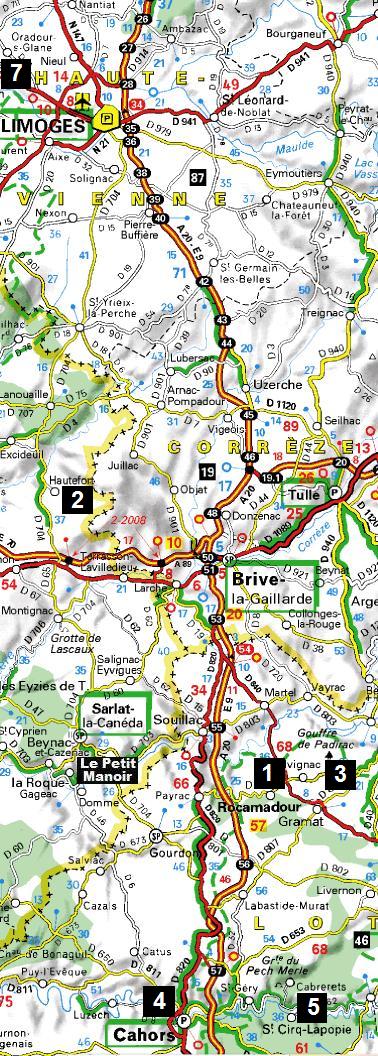Map of the region


Dominating the surroundings from the top of a rocky outcrop, Hautefort Castle stands out from its many Périgourdine cousins defensive by its elegant style of pleasure castle. The Marquises de Hautefort had spent a great deal of time at the court of France, and had a taste more like that of the Loire Valley than that of the Perigord.
The castle of Hautefort which is visited today has succeeded several medieval buildings. In its current version, it was designed in the late sixteenth century by two architects who did not come from the region: one came from Lorraine and the other was Parisian.
Beyond the splendor of the 30-hectare park and the architecture of the building, Hautefort Castle contains an impressive collection of paintings and tapestries from the 17th century. In season, many animations take place there.
www.chateau-hautefort.com
Rocamadour is a great site, a miraculous rock, an extraordinary town dizzying seven sanctuaries tangled, place of pilgrimage since 1166 on one of the famous "Chemins de St Jacques de Compostela" still very popular today.
The village, dating from 1166, is built in stages in the vertical cliff above the Alzou, on three levels. Downstairs, the town with its narrow streets and old half-timbered houses. In the middle of the cliff, the religious city and its seven sanctuaries, reached by climbing the 216 steps of the famous Grand Staircase, formerly climbed on its knees by the pilgrims. And at the top, on the plateau towards which you climb a path of cross shaded in laces, the Castle and the ramparts.
It is advisable to arrive by the Hospitalet road to admire the whole site from the point of view, then to park up near the castle. The castle can not be visited, but you can access the ramparts (entrance fee) and from there, the views overlooking the village are spectacular. The descent to the religious city and the village is pleasant, and to go up, two elevators are at your disposal.
www.vallee-dordogne.com/rocamadour
The Padirac Gulf, discovered in 1889, is a deep network of drowned caves, among the largest in the world. The guided tour begins with a boat trip on an underground river, 100 meters underground. The height of the caves varies: from a few centimeters above your head up to 91 meters high for the Grand Dome. The tour continues on foot, admiring the caves, stalactites and waterfalls.
The speleological exploration has discovered traces of prehistoric life in this underground place.
In summer, there is often a crowd and a delay.
Online ticketing:
www.gouffre-de-padirac.com
Capital of Quercy, Cahors is labeled "City of Art and History" for its remarkable saved area. The Valentré bridge, its most famous monument, is a fortified bridge with three towers, built in 1308 to prevent the English from entering Cahors. In the city itself, the cathedral has a magnificent Romanesque portal, and the medieval alleys are worth a visit.
Cahors is also well known for its robust red wine, produced in the region for centuries.
Saint Cirq-Lapopie dominates the Lot with a height of 80 meters, the village was built by large feudal families, which have succeeded artists in the twentieth century. The village is accessible by stone doors in fortified walls. Charming little cobbled streets are lined with rich medieval houses, many of which have pretty little gardens. We can see ruins of three castles and a fortified church of the fifteenth century.
Saint Cirq-Lapopie is officially classified as "one of the most beautiful villages in France". It is the first tourist destination in the Lot department.
Not far from St Cirq Lapopie are the caves of Pech-Merle, with large rooms decorated with concretions and remarkable wall carvings. In summer, it is prudent to book the entrance 3 days before, and road access is quite narrow.
www.saint-cirqlapopie.com
Saint Emilion is an elegant little village on the hillsides of the Dordogne, world famous for its remarkable wines. Saint-Emilion and its vineyards derive their originality from the limestone which offers an exceptional soil to its vines. Created by a Breton monk, St Emilion, in the 8th century, the city of St Emilion was for centuries inhabited by monastic communities worshiping the Patron Saint founder of the place, who developed, among other things, the culture of the vine.
The Jurisdiction of Saint-Emilion was listed as a World Heritage Site in 1999 under the title "Cultural Landscape". It was the first classified vineyard in the world. It consists of seven communes in addition to St Emilion, for 5000 hectares of classified vineyards, dotted with hundreds of "Châteaux" wine.
In addition to its great wines, St Emilion also offers the visitor its considerable historical and architectural heritage with the medieval city of Saint-Émilion, its monolithic church, underground quarries, cobbled streets and numerous religious monuments.
www.saint-emilion-tourisme.com
En route to St Emilion, wine tourism enthusiasts can also stop at the House of Wines Bergerac, which offers a fine selection of wines of this appellation, at prices much more affordable than the cheapest St Emilion!
The small village of Oradour-sur-Glane unfortunately became famous for a massacre committed by German troops during the Second World War.
On June 10, 1944, the 642 inhabitants of Oradour-sur-Glane were brutally killed by a division of Waffen-SS.
190 men were shot in a barn, 247 women and 205 children were first locked up in the church and burned alive. That night, the village was razed.
Oradour-sur-Glane was preserved in the state in which the village was left by the Germans on June 10, 1944. A new village was built a little further. Today, the tragic history of the place is commemorated in the "Center of Memory", inaugurated in 1999.
www.oradour.org
Prêt pour venir visiter le Périgord ?
Réservez votre gîtes près de Sarlat à Vitrac au Petit Manoir
